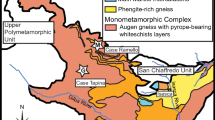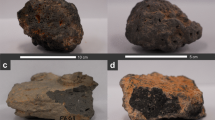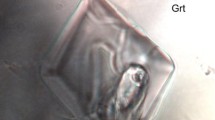Abstract
Analysis of mineral inclusions in chemically and physically resistant hosts has proven to be valuable for reconstructing the P–T exhumation history of high-grade metamorphic rocks. The occurrence of cristobalite-bearing inclusions in garnets from Gore Mountain, New York, is unexpected because the peak metamorphic conditions reached are well removed (>600 °C too cold) from the stability field of this low-density silica polymorph that typically forms in high temperature volcanic environments. A previous study of samples from this area interpreted polymineralic inclusions consisting of cristobalite, albite and ilmenite as representing crystallized droplets of melt generated during a garnet-in reaction, followed by water loss from the inclusion to explain the reduction in inclusion pressure that drove the transformation of quartz to cristobalite. However, the recent discovery of monomineralic inclusions of cristobalite from the nearby Hooper Mine cannot be explained by this process. For these inclusions, we propose that the volume response to pressure and temperature changes during exhumation to Earth’s surface resulted in large tensile stresses within the silica phase that would be sufficient to cause transformation to the low-density (low-pressure) form. Elastic modeling of other common inclusion–host systems suggests that this quartz-to-cristobalite example may not be a unique case. The aluminosilicate polymorph kyanite also has the capacity to retain tensile stresses if exhumed to Earth’s surface after being trapped as an inclusion in plagioclase at P–T conditions within the kyanite stability field, with the stresses developed during exhumation sufficient to produce a transformation to andalusite. These results highlight the elastic environment that may arise during exhumation and provide a potential explanation of observed inclusions whose stability fields are well removed from P–T paths followed during exhumation.






Similar content being viewed by others
References
Abeele WV, Wheeler ML, Burton BW (1981) Geohydrology of bandelier tuff. In: Los Alamos National Laboratory Report LA-8962
Alvarenga AD, Grimsditch M, Bodnar RJ (1993) Elastic properties of water under negative pressures. J Chem Phys 98(11):8392–8396
Angel RJ, Brown JM, Abramson E, Johnson E (2006) Elasticity of plagioclase feldspars. Geol Soc Am Abstr Progr 38(7):114
Angel RJ, Mazzucchelli ML, Alvaro M, Nimis P, Nestola F (2014) Geobarometry from host-inclusion systems: the role of elastic relaxation. Am Mineral 99(10):2146–2149
Ashley KT, Caddick MJ, Steele-MacInnis M, Bodnar RJ, Dragovic B (2014) Geothermobarometric history of subduction recorded by quartz inclusions in garnet. Geochem Geophys Geosyst 15(2):350–360. doi:10.1002/2013GC005106
Barrow NJ, Bowden JW (1987) A comparison of models for describing the adsorption of anions on a variable charge mineral surface. J Colloid Interface Sci 119(1):236–250
Bonamici CE, Kozdon R, Ushikubo T, Valley JW (2011) High-resolution P–T–t paths from δ 18O zoning in titanite: a snapshot of late-orogenic collapse in the Grenville of New York. Geology 39(10):959–962
Briggs RJ, Ramdas AK (1977) Piezospectroscopy of the Raman spectrum of α-quartz. Phys Rev B 16(8):3815–3826
Casimir HBG (1948) Proc Kon Ned Akad Wetensch B51:793
Caupin F, Stroock AD (2013) The stability limit and other open questions on water at negative pressure. Liq Polymorph Adv Chem Phys 152:51–80
Chopin C (1984) Coesite and pure pyrope in high-grade blueschists of the Western Alps: a first record and some consequences. Contrib Mineral Petrol 86:107–118
Cole SS (1934) The conversion of quartz into cristobalite below 1000 °C, and some properties of the cristobalite formed. American ceramic society (refractories division), Cincinnati
Connolly JAD (2009) The geodynamic equation of state: what and how. Geochem Geophys Geosyst 10(10):1–19
Darling RS (2013) Zircon-bearing, crystallized melt inclusions in peritectic garnet from the western Adirondack Mountains, New York State, USA. Geofluids 13:453–459
Darling RS, Chou IM, Bodnar RJ (1997) An occurrence of metastable cristobalite in high-pressure garnet granulite. Science 276(5309):91–93
DeVore GW (1956) Surface chemistry as a chemical control on mineral association. Geology 64(1):31–55
Eitel W (1957) Structural anomalies in tridymite and cristobalite. Am Ceram Soc Bull 57:142–148
Enami M (2012) Influence of garnet hosts on the Raman spectra of quartz inclusions. J Mineral Petrol Sci 107:173–180
Enami M, Nishiyama T, Mouri T (2007) Laser Raman microspectrometry of metamorphic quartz: a simple method for comparison of metamorphic pressures. Am Mineral 92(1303–1):315
Fall A, Rimstidt JD, Bodnar RJ (2009) The effect of fluid inclusion size on determination of homogenization temperature and density of liquid-rich aqueous inclusions. Am Mineral 94:1569–1579
Fenner CN (1913) The stability relations of the silica minerals. Am J Sci 36:331–384
Florence FP, Darling RS, Orrell SE (1995) Moderate pressure metamorphism and anatexis due to anorthosite intrusion, western Adirondack Highlands, New York. Contrib Mineral Petrol 121:424–436
Flörke OW (1955) Strukturanomalien bei Tridymit und Cristobalit. Ber Deut Keram Ges 32:369–381
Gillet P, Ingrin J, Chopin C (1984) Coesite in subducted continental crust: P–T history deduced from an elastic model. Earth Planet Sci Lett 70:426–436
Green JC, Fitz TJ III (1993) Extensive felsic lavas and rheoignimbrites in the Keweenawan Midcontinent Rift plateau volcanics, Minnesota: petrographic and field recognition. J Volcanol Geotherm Res 54:177–196
Grevel C, Schreyer W, Grevel K-D, Schertl H-P, Willner AP (2009) REE distribution, mobilization and fractionation in the coesite-bearing ‘pyrope quartzite’ and related rocks of the Dora-Maira Massif, Western Alps. Eur J Mineral 21:1213–1224
Guiraud M, Powell R (2006) P–V–T relationships and mineral equilibria in inclusions in minerals. Earth and Planet Sci Lett 244:683–694
Heaney PJ (1994) Structure and chemistry of the low-pressure silica polymorphs. In: Heaney PJ, Prewitt CT, Gibbs GV (eds) Silica: physical behavior, geochemistry, and materials applications, vol 29. Mineralogical Society of America, Washington, D.C., pp 1–40
Hill VG, Roy R (1958) Silica structure studies VI. On tridymite. Trans Br Ceram Soc 57:496–510
Hoisch TD, Wells ML, Grove M (2008) Age trends in garnet-hosted monazite inclusions from upper amphibolite facies schists in the northern Grouse Creek Mountains, Utah. Geochim Cosmochim Acta 72(22):5505–5520
Holland TJB, Powell R (1998) An internally consistent thermodynamic data set for phases of petrological interest. J Metamorph Geol 16:309–343
Holland T, Powell R (2011) An improved and extended internally consistent thermodynamic dataset for phases of petrological interest, involving a new equation of state for solids. J Metamorph Geol 29:333–383
Horwell CJ, WIlliamson BJ, Llewellin EW, Damby DE, Le Blond JS (2013) The nature and formation of cristobalite at the Soufrière Hills volcano, Montserrat: implications for the petrology and stability of silicic lava domes. Bull Volcanol 75:19
Kingma KJ, Hemley RJ (1994) Raman spectroscopic study of microcrystalline silica. Am Mineral 79:269–273
Klasik JA (1975) High cristobalite and high tridymite in a middle Eocene deep-sea chert. Science 189(4203):631–632
Klein C, Hurlbut CSJ (1993) Manual of mineralogy, 21st edn. Wiley, New York
Kohn MJ (2014) “Geoba-Raman-try”: calibration of spectroscopic barometers and thermometers for mineral inclusions. Earth and Planet Sci Lett 388:187–196
Kouketsu Y, Nishiyama T, Ikeda T, Enami M (2014) Evaluation of residual pressure in an inclusion-host system using negative frequency shift of quartz Raman spectra. Am Mineral 99:433–442
Kretz R (1966) Interpretation of the shape of mineral grains in metamorphic rocks. J Petrol 7(1):68–94
Krüger Y, Stoller P, Rička J, Frenz M (2007) Femtosecond lasers in fluid inclusion analysis: overcoming metastable phase states. Eur J Mineral 19:693–706
Levin SB (1950) Genesis of some Adirondack garnet deposits. Geol Soc Am Bull 61(6):519–565
Matthews A, Schliestedt M (1984) Evolution of the blueschist and greenschist facies rocks of Sifnos, Cyclades, Greece—a stable isotope study of subduction-related metamorphism. Contrib Mineral Petrol 88:150
McSkimin HJ, Andreatch P (1972) Elastic moduli of diamond as a function of pressure and temperature. J Appl Phys 43:2944–2948
Mezger K, Rawnsley CM, Bohlen SR, Hanson GN (1991) U-Pb garnet, titanite, monazite, and rutile ages: implications for the duration of high-grade metamorphism and cooling histories, Adirondack Mountains, New York. J Geol 99:415–428
Moehlman RS (1935) Quartz paramorphs after tridymite and cristobalite. Am Mineral 20:808–810
Mosenfelder JL, Bohlen SR (1997) Kinetics of the coesite to quartz transformation. Earth and Planet Sci Lett 153:133–147
Nishiyama T, Aikawa K (2011) Implication of the residual pressure recorded in quartz inclusions in garnet from high T metamorphic terranes. Japan Geoscience Union Meeting Abstract: SMP046-005
Parkinson CD, Katayama I (1999) Present-day ultrahigh-pressure conditions of coesite inclusion in zircon and garnet: evidence from laser Raman microspectroscopy. Geology 27:979–982
Pearson DG, Brenker FE, Nestola F, McNeill J, Nasdala L, Hutchison MT, Matveev S, Mather K, Silversmit G, Schmidt S, Vekemans B, Vincze L (2014) Hydrous mantle transition zone indicated by ringwoodite included within diamond. Nature 507:221–224
Perrillat JP, Daniel I, Lardeaux JM, Cardon H (2003) Kinetics of the coesite-quartz transition: application to the exhumation of ultrahigh-pressure rocks. J Petrol 44(4):773–788
Rivera E, Celaya LE, Rincόn JM (1987) Microstructural characterization of an opal glass in the Na2O–CdO–SiO2 system. Mater Lett 5(5,6):185–188
Roedder E (1967) Metastable superheated ice in liquid-water inclusions under high negative pressure. Science 155:1413–1417
Sarnoski AH, Severs MJ, Remuzzi MR, Booty SJ (2011) Geochemical investigation of Adirondack garnets. Geol Soc Am Abstr Progr 43(1):65
Sato M (1963) X-ray study of tridymite (1): on tridymite M and tridymite S. Mineral J (Japan) 4:115–130
Sato K, Santosh M, Tsunogae T (2009) A petrologic and laser Raman spectroscopic study of sapphirine–spinel–quartz–Mg-staurolite inclusions in garnet from Kumiloothu, southern India: implications for extreme metamorphism in a collisional orogen. J Geodyn 47:107–118
Schmidt C, Ziemann MA (2000) In-situ Raman spectroscopy of quartz: a pressure sensor for hydrothermal diamond-anvil cell experiments at elevated temperatures. Am Mineral 85:1725–1734
Shen AH, Bassett WA, Chou IM (1993) The α–β transition at high temperatures and pressures in a diamond-anvil cell by laser interferometry. Am Mineral 78:694–698
Smith DC (1984) Coesite in clinopyroxene in the Caledonides and its implications for geodynamics. Nature 310:641–644
Spear FS, Markussen JC (1997) Mineral zoning, P–T–X–M phase relations, and metamorphic evolution of some Adirondack Granulites, New York. J Petrol 38(6):757–783
St-Onge MR (1987) Zoned poikiloblastic garnets: P–T paths and syn-metamorphic uplift through 30 km of structural depth, Wopmay Orogen, Canada. J Petrol 28:1–21
Tajčmanová L, Podladchikov Y, Powell R, Moulas E, Vrijmoed JC, Connolly JAD (2014) Grain-scale pressure variations and chemical equilibrium in high-grade metamorphic rocks. J Metamorph Geol 32:195–207
Van der Molen I, Van Roermund HLM (1986) The pressure path of solid inclusions in minerals: the retention of coesite inclusions during uplift. Lithos 19:317–324
Van Valkenburg A, Buie BF (1945) Octahedral cristobalite with quartz paramorphs from Ellora Caves, Hyderabad State, India. Am Mineral 30:526–535
Vityk MO, Bodnar RJ, Schmidt C (1994) Fluid inclusions as tectonothermobarometers: relation between P–T history and re-equilibration morphology during crustal thickening. Geology 22:731–734
Vityk MO, Bodnar RJ, Dudok IV (1995) Natural and synthetic re-equilibration textures of fluid inclusions in garnet (Marmarosh Diamonds): evidence for refilling under conditions of compressive loading. Eur J Mineral 7:1071–1087
Wang Z, Ji S (2001) Elasticity of six polycrystalline silicate garnets at pressure up to 3.0 GPa. Am Mineral 86:1209–1218
Zhang H, Banfield JF (2014) Interatomic Coulombic interactions as the driving force for oriented attachment. CrystEngComm 16:1568–1578
Acknowledgments
We thank Matthew Steele–MacInnis for thoughtful discussions on several aspects of this study. We appreciate constructive reviews by Richard Palin and Evangelos Moulas, and for review of earlier drafts of this manuscript by Frank Spear and John Wheeler which greatly improved the quality of this work.
Author information
Authors and Affiliations
Corresponding author
Additional information
Communicated by Timothy L. Grove.
Rights and permissions
About this article
Cite this article
Ashley, K.T., Darling, R.S., Bodnar, R.J. et al. Significance of “stretched” mineral inclusions for reconstructing P–T exhumation history. Contrib Mineral Petrol 169, 55 (2015). https://doi.org/10.1007/s00410-015-1149-0
Received:
Accepted:
Published:
DOI: https://doi.org/10.1007/s00410-015-1149-0




